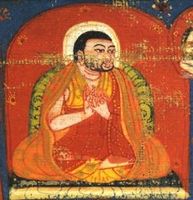Phag mo gru pa rdo rje rgyal po
Jump to navigation
Jump to search
Phag mo gru pa rdo rje rgyal po on the DRL
ཕག་མོ་གྲུ་པ་རྡོ་རྗེ་རྒྱལ་པོ་
| Wylie | phag mo gru pa rdo rje rgyal po |
|---|---|
| English Phonetics | Pakmodrupa Dorje Gyalpo |
Other names
- ཕག་མོ་གྲུ་པ་
- phag mo gru pa
Dates
| Birth: | 1110 |
|---|---|
| Death: | 1170 |
Tibetan calendar dates
| Day | |
|---|---|
| Month | |
| Gender | Male |
| Element | Iron |
| Animal | Tiger |
| Rab Jyung | 2 |
About
- Religious Affiliation
- phag gru bka' brgyud
- Teachers
- Sa chen kun dga' snying po · Sgam po pa · Phywa pa chos kyi seng+ge
- Students
- 'bri gung skyob pa 'jig rten mgon po · gling ras pa pad+ma rdo rje · stag lung thang pa bkra shis dpal · gyer sgom tshul khrims seng+ge · Khro phu lo tsA ba byams pa'i dpal · 'gro mgon ras chen
Other Biographical info:
He was the older brother or cousin of KaH thog dam pa bde gshegs.
Links
- BDRC Link
- https://www.tbrc.org/#!rid=P127
- Treasury of Lives Link
- https://treasuryoflives.org/biographies/view/Pakmodrupa-Dorje-Gyelpo/2539
- Treasury of Lives Excerpt
- Himalayan Art Resources Link or Other Art Resource
- https://www.himalayanart.org/search/set.cfm?setID=956
- Wiki Pages
Buddha Nature Project
- Person description or short bio
- A Tibetan scholar and adept who is counted as one of the great disciples of the key Bka’ brgyud founder Sgam po pa Bsod nams rinchen, and is venerated as the source for many subsequent Bka’ brgyud lineages. Born in the ’Bri lung rme shod region of eastern Tibet, Phag mo gru pa’s parents died while he was still young. Receiving ordination as a novice Buddhist monk at the age of eight, he studied under a variety of teachers during the early part of his life. At eighteen, he traveled to central Tibet, receiving full ordination at the age of twenty-five. There he trained under a number of Bka’ gdams pa teachers, and later, under the great Sa skya master Sa chen Kun dga snying po, from whom he received extensive instruction in the tradition of the path and its result (lam ’bras). At the age of forty, he traveled to Dwags lha sgam po in Southern Tibet, where he met Sgam po pa, who became his principal guru. Sgam po pa famously held up a half-eaten ball of parched barley flour mixed with tea and said to Phag mo gru pa, “This is greater than the results of all your previous meditation.” After he demonstrated his humility by carrying stones to build a stūpa, Sgam po pa gave Phag mo gru pa the transmission of instructions on mahāmudrā meditation and, through their practice, is said to have attained great realization. In 1158, Phag mo gru pa established a simple meditation hut where he lived until his death in 1170; this location later served as the foundation for the influential monastery of Gdan sa mthil. Phag mo gru pa was renowned for his strict adherence to the vinaya, even going on alms rounds, a rare practice in Tibet. Several individuals among his many followers established a number of important branch lineages, the so-called “eight minor Bka’ brgyud subsects” that collectively came to be known as the Phag gru Bka’ brgyud. (Source: "Phag mo gru pa Rdo rje rgyal po." In The Princeton Dictionary of Buddhism, 639. Princeton University Press, 2014. http://www.jstor.org/stable/j.ctt46n41q.27.)
Expand to see this person's philosophical positions on Buddha-nature.
| Is Buddha-nature considered definitive or provisional? | |
|---|---|
| Position: | |
| Notes: | |
| All beings have Buddha-nature | |
| Position: | |
| If "Qualified", explain: | |
| Notes: | |
| Which Wheel Turning | |
| Position: | |
| Notes: | |
| Yogācāra vs Madhyamaka | |
| Position: | |
| Notes: | |
| Zhentong vs Rangtong | |
| Position: | |
| Notes: | |
| Promotes how many vehicles? | |
| Position: | |
| Notes: | |
| Analytic vs Meditative Tradition | |
| Position: | |
| Notes: | |
| What is Buddha-nature? | |
| Position: | Tathāgatagarbha as the Resultant State of Buddhahood |
| Notes: | #From Śākya Chogden's summary of the main positions on buddha nature his view is included among the heading "Asserting buddha nature as the compound of natural purity and buddha qualities’ being inseparable" and with the sub-heading of "Asserting those qualities to be the qualities of the fruitional dharmakāya of realization (many Kagyüpas such as Pamo Trupa)." Brunnhölzl, K., When the Clouds Part, p. 79.
|
| Svātantrika (རང་རྒྱུད་) vs Prāsaṅgika (ཐལ་འགྱུར་པ་) | |
| Position: | |
| Notes: | |
| Causal nature of the vajrapāda | |
| Position: | |
